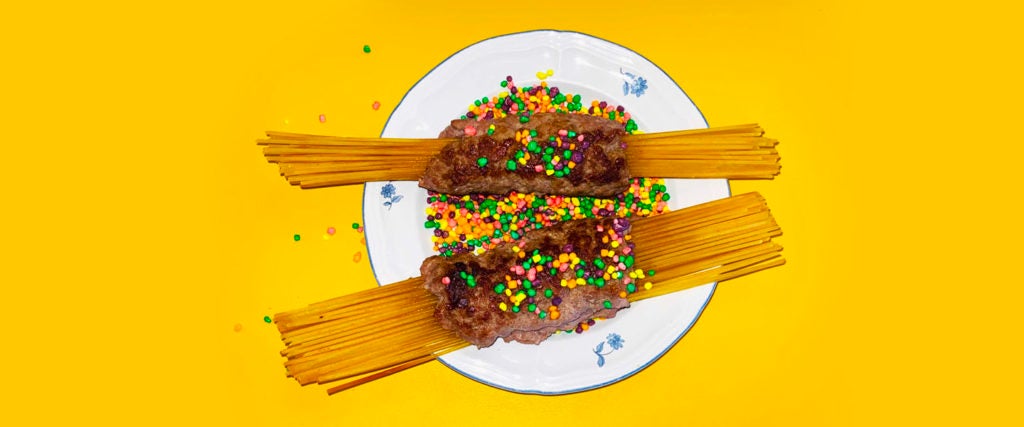As your resident dirtbag chef, I can see no way to avoid addressing the Nerds-coated elephant in the room:
@gettishow This is how you make Getti Spaghetti ? #hamburgermeat #spaghetti #pasta #groundbeef #wrapped #ghetti #gettispaghetti #nerdscandy
This video went viral a couple weeks ago and has been my chief psychological torment ever since. Every step is somehow more insulting than the last. At no point during the preparation of this dish does its creator, TikTok user GettiShow, reveal any knowledge of how to cook noodles or ground beef. Finally, the dish is topped off with Nerds. You know, Nerds candy, that can’t-miss ingredient in your nonna’s lasagna. Remember when the late, great Marcella Hazan rocked the English-speaking world with her Italian cookbook full of Nerds recipes?
Don’t get me wrong. My inclination is to treat novice, fumbling cooks with kindness. I was a fumbling novice myself not so long ago. If I’m harsher than usual with Getti, it’s because I suspect that this is no clumsy but ultimately benign cook. Something more insidious is going on with this latest generation of viral food TikTokers and YouTubers, with anyone who’s realized they can grab their 15 minutes of fame by wasting food.
This is probably pretty rich coming from ole Rax “Beef Hand” King. So I’m willing to deep-fry a sickly wad of hand-shaped beef, but all of a sudden I’m too good to sprinkle Nerds on my meat-wrapped raw spaghetti strands?
Fair enough, but hear me out: Chefclub TV’s beef hand, though its recipe emphasized the surreal over the tasty, was ultimately 100 percent edible. It certainly wasn’t my favorite thing that I ever cooked, but I was comfortable eating it. At the time, a representative of Chefclub had this to say about the company’s approach to recipe development: “[Chefclub’s U.S. country manager Hannah] Petertil characterizes Chefclub’s visual signature as ‘fun-first,’ which isn’t always applicable when taking a recipe offline. ‘We don’t expect you to use as much cheese as we do, but people love watching cheese on camera,’ Petertil explains. ‘We give people what they want. Our aesthetic is for the people.’”
If Chefclub deliberately cooks mediocre food because it looks good on camera, Getti and her ilk are doing something even worse. They’re cooking disgusting, often inedible food because the sight of it upsets people so much that they feel they have to say something. At the end of the day, you can argue that the Chefclub crew aren’t wasting food, exactly. No, they’re not treating food with the respect you may think it deserves, but neither are they buying it just to combine it in shock-inducing ways and then (presumably) throw it away.
And yet, the question remains: Is viral food waste as meaningful as it is annoying to those of us who dislike it? Or is it just an easy target for people who are enraged by, and feel powerless in the face of, food waste?
Take the “ramen bathtub challenge,” a practice whose origins are mysterious but which originally became popular on YouTube a few years ago. It has since made its disgusting way over to TikTok. The aspiring viral-goer loads up a bathtub with a few dozen packs of uncooked instant ramen, fills the tub with water, and gets in. These videos aren’t popular because people keep quote-tweeting them to say what a good job the ramen bather in question is doing. No, the responses are almost universally negative. And yet, a despised viral video is still a viral video. As digital culture expert Jamie Cohen pointed out in Marris Adikwu’s story for Eater about the memeification of food waste, the point of trying to go viral with one’s appalling food behavior isn’t to get a positive reaction. It’s to get a reaction of any kind.
This is where I keep getting stuck. What is the appropriate response to a video of a person proudly wasting food, a critical resource that many people don’t have enough of? Watching these videos feels like seeing the entertainment division of some grand consumerist enterprise being put to work. In fact, the more I think about it, are these fame-hungry jags doing something that different from, say, stepping onto a Food Network soundstage to prepare sample meals that nobody needs to eat for sustenance? Am I being the Grinch Who Stole Cooking TikTok, humorless and haughty because I just plain don’t like the look of a bathtub filled to the brim with ramen that people could be eating?
Because it’s true that the optics of this behavior are, to use the medical term, absolutely suck-ass. At the same time, I can’t think of what I’d suggest to some jerkoff who wants to get famous by slapping together a pile of dogshit and calling it spaghetti except: Please don’t. My complaining is as toothless as it is sanctimonious.
I hate the viral cooking TikToks because they’re easy to hate, but I also know that GettiShow didn’t invent food waste, or even capitalizing on the shitty optics of food waste. A wasted pound of ground beef is nothing compared to the food waste our government routinely sanctions. Remember those cops guarding the dumpster outside Fred Meyer, refusing to let people take food that the grocery store had already thrown away? Remember the start of the pandemic, when farmers destroyed millions of pounds of perfectly serviceable food because they were no longer able to sell it to restaurants?
No matter how much I personally hate the sight of a bathtub filled with ramen, I can’t argue that filming one stupid video isn’t comparable in scale or destruction to that sort of food violence. All I can do is meekly say, “Hey, maybe don’t bother quote-tweeting yet another garbage food video,” usually after having already quote-tweeted the damn thing myself because I’m as powerless as anybody else in the face of offensive food behavior. If I were given the choice to pull a lever and implement a world without any further viral food videos, I’d do it. But I won’t ever be given that choice, which is sort of the point: We have just as little control over this small-scale, idiotic food waste as we do over the larger scale food waste that keeps the gears of capitalism turning the way they need to turn to maximize profits.
I think we hate bad cooking videos because they operate on such a human scale. We can abstractly despise farm owners and cops for wasting food in service to capitalism, but the numbers attached to that waste make it strangely impersonal. Which person among us is capable of single-handedly salvaging 3.7 million gallons of milk? Or 750,000 chicken eggs? What we can do, and do comfortably, is reply “stop wasting food” to some fool who just took a ramen bath and probably won’t even see what we said. In both cases, we’re equally hamstrung and helpless, but at least the latter case feels like doing some version of the right thing. Plus, it allows us to blow off steam, an act for which we’re developing an ever-increasing need in the face of all the doom we can’t control.
A really bad viral food video won’t change any of the grievous inequities in our supply chain or within our country’s approach to food production. Aside from maybe inspiring a few weeks of knock-off videos from other creators, it won’t have any lasting impact at all. But it’ll piss me off, and fill me with distaste for its creator’s profligacy, and drive me straight to the quote-tweet button every time.

